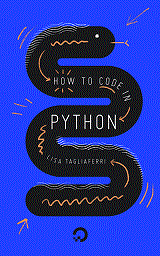
|
FreeComputerBooks.com
Links to Free Computer, Mathematics, Technical Books all over the World
|
|
- Title How To Code in Python 3
- Author(s) Lisa Tagliaferri
- Publisher: DigitalOcean (2018)
- License(s): CC BY-NC-SA 4.0
- Paperback N/A
- eBook HTML, PDF (459 pages), ePub, and Mobi
- Language: English
- ISBN-10/ASIN: N/A
- ISBN-13: 978-0999773017
- Share This:

|
An introduction to computer programming with Python 3. Helps the readers in learning the key concepts of Python and understanding how programs work while also imparting foundational logic that can serve the readers in other domains.
Learning the key concepts of Python can help you understand how programs work while also imparting foundational logic that can serve you in other domains. Understanding what Python and computer programming can offer you both as a user and as a developer is important as technology is further integrated into daily life.
This book is designed to bring developers and others who are anxious to learn Python up to speed quickly. Not only does it teach the basics of syntax, but it condenses years of experience. You will learn warts, gotchas, best practices and hints that have been gleaned through the years in days. You will hit the ground running and running in the right way.
About the Authors- Lisa Tagliaferri is Senior Manager of Developer Education at DigitalOcean. She is a Digital Humanities researcher at Villa I Tatti, The Harvard University Center for Italian Renaissance Studies.

- How To Code in Python 3 (Lisa Tagliaferri)
- The Mirror Site (1) - PDF, ePub, and Mobi
- The Mirror Site (2) - PDF
-
 Python Programming Exercises, Gently Explained (Al Sweigart)
Python Programming Exercises, Gently Explained (Al Sweigart)
This is the perfect book for beginner and intermediate programmers who want to test their Python skills but aren’t ready to begin professional-level software development. The 42 programming exercises in this book let you practice what you've learned.
-
 Beyond the Basic Stuff with Python: Writing Clean Code
Beyond the Basic Stuff with Python: Writing Clean Code
More than a mere collection of advanced syntax and masterful tips for writing clean code, advance your Python programming skills by using the command line and other professional tools like code formatters, type checkers, linters, and version control.
-
 Python Packages (Tomas Beuzen, et al.)
Python Packages (Tomas Beuzen, et al.)
An open source book that describes modern and efficient workflows for creating Python packages. Covering the entire Python packaging life cycle, this essential guide takes readers from package creation all the way to effective maintenance and updating.
-
 Deep Learning with Python, 2nd Edition (Francois Chollet)
Deep Learning with Python, 2nd Edition (Francois Chollet)
This book introduces the field of deep learning using Python and the powerful Keras library. It offers insights for both novice and experienced machine learning practitioners, and builds your understanding through intuitive explanations and practical examples.
-
 Architecture Patterns with Python (Harry Percival, et al.)
Architecture Patterns with Python (Harry Percival, et al.)
Enabling Test-Driven Development, Domain-Driven Design, and Event-Driven Microservices, it introduces proven architectural design patterns to help Python developers manage application complexity, and get the most value out of their test suites.
-
 Clean Architectures in Python: Better Software Design
Clean Architectures in Python: Better Software Design
The clean architecture is the opposite of spaghetti code, where everything is interlaced and there are no single elements that can be easily detached from the rest and replaced without the whole system collapsing.
-
 Automate the Boring Stuff with Python (Albert Sweigart)
Automate the Boring Stuff with Python (Albert Sweigart)
Learn how to use Python to write programs that do in minutes what would take you hours to do by hand - no prior programming experience required. You'll create Python programs that effortlessly perform useful and impressive feats of automation.
-
 Python for Everybody: Exploring Data in Python 3
Python for Everybody: Exploring Data in Python 3
This book is designed to introduce students to programming and software development through the lens of exploring data. You can think of the Python programming language as your tool to solve data problems that are beyond the capability of a spreadsheet.
-
 Problem Solving with Algorithms/Data Structures using Python
Problem Solving with Algorithms/Data Structures using Python
This is a textbook about computer science. It is also about Python. However, there is much more. The tools and techniques that you learn here will be applied over and over as you continue your study of computer science.
-
 Fundamentals of Python Programming (Richard L. Halterman)
Fundamentals of Python Programming (Richard L. Halterman)
It focuses on introducing programming techniques and developing good habits. To that end, our approach avoids some of the more esoteric features of Python and concentrates on the programming basics that transfer directly to other imperative programming.
-
 O'Reilly® Think Python, 2nd Edition (Allen B. Downey)
O'Reilly® Think Python, 2nd Edition (Allen B. Downey)
This hands-on guide takes you through the Python programming language a step at a time, beginning with basic programming concepts before moving on to functions, recursion, data structures, and object-oriented design. 2nd edition updated for Python 3.
-
 The Big Book of Small Python Projects: 81 Easy Practice Programs
The Big Book of Small Python Projects: 81 Easy Practice Programs
This book demonstrates how to combine different libraries and frameworks to build amazing things. It picks up where the complete beginner books leave off, expanding on existing concepts and introducing new tools that you'll use every day.
-
 Practical Python Projects (Yasoob Khalid)
Practical Python Projects (Yasoob Khalid)
This collection of 81 Python projects will have you making digital art, games, animations, counting programs, and more right away. Once you see how the code works, you’ll practice re-creating the programs and experiment by adding your own custom touches.





